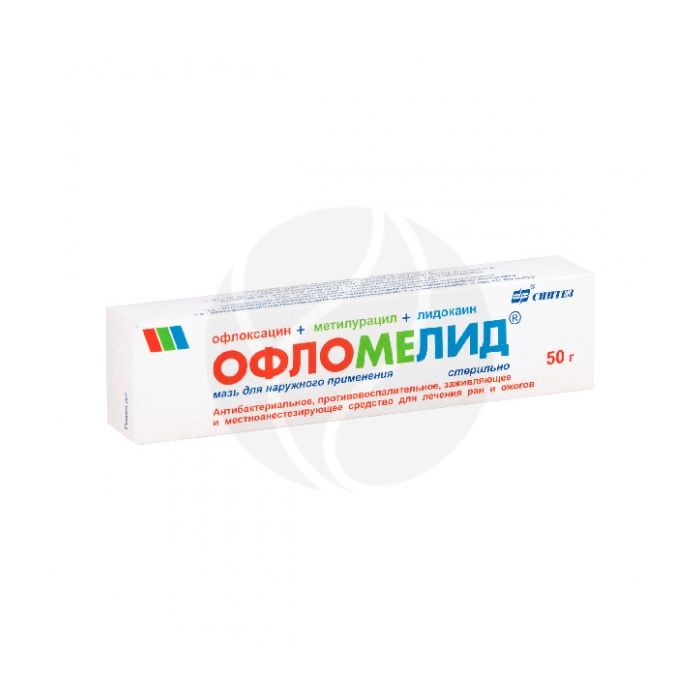Oflomelide ointment, 50g
Russian Pharmacy name:
Офломелид мазь , 50г
Infected wounds of various localization and etiology in the first (purulent-necrotic) phase of the wound process, incl. accompanied by severe pain syndrome (infected burns of II-IV degree, bedsores, trophic ulcers, postoperative and post-traumatic wounds and fistulas, wounds after opening abscesses, phlegmon, after surgical treatment of abscessing boils, carbuncles, hydradenitis, suppurating atheroma, lipomas, etc. .).
Outwardly, once a day for 1-2 weeks. After standard treatment of wounds and burns, the ointment is applied directly to the wound surface with a thin layer (after which a sterile gauze bandage is applied) or on a gauze bandage followed by application to the lesion. Tampons soaked in ointment loosely fill the cavities of purulent wounds after their surgical treatment, and gauze turundas with ointment are injected into the fistulous passages. In the treatment of purulent wounds, the ointment is used once a day, in the treatment of burns - daily or 2-3 times a week, depending on the amount of purulent discharge. The maximum daily dose should not exceed 100 g. The duration of treatment depends on the dynamics of cleansing wounds from purulent exudate and the timing of the relief of the inflammatory process. Side effect Allergic reactions.
active substances: ofloxacin - 1 g, dioxomethyltetrahydropyrimidine (methyluracil) - 4 g, lidocaine hydrochloride monohydrate (in terms of lidocaine hydrochloride) - 3 g;
excipients: methyl parahydroxybenzoate (nipagin or methylparaben), propyl parahydroxybenzoate (nipazol or propylparaben), propylene glycol, macrogol-1500 (low molecular weight polyethylene glycol-1500, polyethylene oxide-1500), macrogol-400 (low molecular weight polyethylene glycol), polyethylene glycol 400, polyethylene glycol 400
Individual hypersensitivity to the components of the drug, pregnancy, lactation, children under 18 years of age.
Trade name of the drug : OflomelidЃ
Dosage form : ointment for external use
Composition per 100 g :
active substances: ofloxacin - 1 g, dioxomethyltetrahydropyrimidine (methyluracil) - 4 g, lidocaine hydrochloride monohydrate (in terms of lidocaine hydrochloride) - 3 g;
excipients: methyl parahydroxybenzoate (nipagin or methylparaben), propyl parahydroxybenzoate (nipazol or propylparaben), propylene glycol, macrogol-1500 (low molecular weight polyethylene glycol-1500, polyethylene oxide-1500), macrogol-400 (low molecular weight polyethylene glycol), polyethylene glycol 400, polyethylene glycol 400
Description : white or almost white ointment.
Pharmacotherapeutic group : antimicrobial combined agent
Pharmacological properties
OflomelidЃ combined preparation has antimicrobial, anti-inflammatory, local anesthetic, regenerating effect. The active substances are ofloxacin, methyluracil and lidocaine.
Ofloxacin is a broad-spectrum antimicrobial agent from the group of fluoroquinolones. It has a bactericidal effect by blocking DNA gyrase in bacterial cells. Active against gram-negative and gram-positive microorganisms.
Methyluracil is a tissue repair stimulant. Possesses anabolic activity.
Accelerates the processes of cell regeneration in wounds, accelerating the growth and granulation maturation of tissue and epithelialization.
Lidocaine has a local anesthetic effect due to blockade of Na + -channels, which prevents the generation of impulses at the endings of sensitive neurons and the conduction of impulses along nerve fibers. When applied externally, it dilates blood vessels, does not have a local irritating effect.
The basis of the ointment is a mixture of polyethylene oxides with a molecular weight of 400 and 1500, which provides a dehydrating effect on tissues 20 times stronger than a 10% sodium chloride solution.
Indications for use
Infected wounds of various localization and etiology in the first (purulent-necrotic) phase of the wound process, incl. accompanied by severe pain syndrome (infected burns of II-IV degree, bedsores, trophic ulcers, postoperative and post-traumatic wounds and fistulas, wounds after opening abscesses, phlegmon, after surgical treatment of abscess boils, carbuncles, hydradenitis, suppurating atheroma, lipomas, etc. .).
Contraindications
Individual hypersensitivity to the components of the drug, pregnancy, lactation, children under 18 years of age.
Method of administration and dosage
Outwardly, once a day for 1-2 weeks. After standard treatment of wounds and burns, the ointment is applied directly to the wound surface with a thin layer (after which a sterile gauze bandage is applied) or on a gauze bandage followed by application to the lesion. Tampons soaked in ointment loosely fill the cavities of purulent wounds after their surgical treatment, and gauze turundas with ointment are injected into the fistulous passages. In the treatment of purulent wounds, the ointment is used once a day, in the treatment of burns - daily or 2-3 times a week, depending on the amount of purulent discharge. The maximum daily dose should not exceed 100 g. The duration of treatment depends on the dynamics of cleansing wounds from purulent exudate and the timing of the relief of the inflammatory process. Side effect Allergic reactions.
Interaction with other drugs
There have been no cases of drug interactions that would lead to a decrease in the effectiveness and safety of the drugs used.
Release form
Ointment for external use. 30 g in aluminum tubes. 30 g, 50 g or 100 g in orange glass jars.
Each tube or jar of 30 g, 50 g, 100 g with instructions for use is placed in a carton box. 1000 g, 2000 g in orange glass jars for hospital.
Storage conditions
In the dark place at a temperature of 15 to 25 ? C.
Keep out of the reach of children.
Shelf life is
2 years. Do not use after the expiration date.
Terms of dispensing from pharmacies
Prescription.

